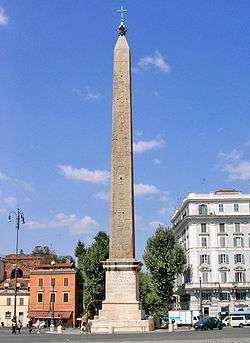Lateran Obelisk
The Lateran Obelisk is the largest standing ancient Egyptian obelisk in the world, and it is also the tallest obelisk in Italy. It originally weighed 413 tonnes (455 short tons), but after collapsing and being re-erected 4 metres (13 ft) shorter, now weighs around 300 tonnes (330 short tons).[1][2] It is located in Rome, in the square across from the Archbasilica of St. John Lateran and the San Giovanni Addolorata Hospital.
| Obelisco Lateranense | |
 Obelisk today across from the Archbasilica of Saint John Lateran | |
| Coordinates | 41°53′12.6″N 12°30′17.2″E |
|---|---|
| Location | Erected in 1588 at Piazza San Giovanni in Laterano in Rome, Italy |
| Designer | Thutmose III and completed by his grandson Thutmose IV in Karnak |
| Type | Obelisk |
| Material | 32.18 metres (105.6 ft) of red granite monolith |
| Height | 45.7 metres (150 ft) |
| Completion date | 15th century B.C. |
History
Originally, the obelisk was created by Pharaoh Thutmose III (1479–1425 BC) for himself and another for his father, but neither were completed before his death. Thutmose III's grandson, Thutmose IV (1400–1390 BC) finished the obelisks and had them erected to the east of the great temple of Amun in Karnakmap. When it was completed, the obelisk now known as the Lateran Obelisk stood at 32m (105 ft) which was the tallest one in Egypt.[3] Both it and the other obelisk, known as the Obelisk of Theodosius, were brought to Alexandria over the Nile by an obelisk ship in the early 4th century by Constantius II. He intended to bring both obelisks to Constantinople, the new capital for the Roman Empire. The Lateran Obelisk never made it.
Circus Maximus
After the obelisk remained in Alexandria for a few decades, Constantius II had the Lateran obelisk shipped to Rome when he made his only visit there in 357. It was erected near the Egyptian obelisk called the Flaminio, which had stood since 10 BC where it was installed by Augustus to decorate the spina of the Circus Maximus.map There they both remained, until after the fall of the Western Roman Empire in the 5th century the Circus Maximus was abandoned and they eventually broke or were taken down. They were eventually buried by mud and detritus carried by a small stream over time.
First person accounts have the original (Roman) base of the monument still in the Circus Maximus as late as 1589.[4] It contained a narrative of Constantius' transport, raising, and dedication of "his father's" obelisk inscribed on its four sides as a long epigram.[5]
Piazza San Giovanni in Laterano
Though pieces of the obelisk had been found in the 14th and 15th centuries, serious excavation was only made possible under Pope Sixtus V. The three pieces of the Lateran obelisk were dug up in 1587, and after being restored by architect Domenico Fontana, the obelisk was re-erected approximately 4 metres (13 ft) shorter. When it was erected near the Lateran Palace and basilica of St. John Lateran on 9 August 1588, it became the last ancient Egyptian obelisk to be erected in Rome. Its location was formerly the spot where the equestrian statue of Marcus Aurelius stood until 1538, when it was relocated to decorate the Piazza del Campidoglio on Capitoline Hill.
The obelisk was topped with a cross and the pedestal was decorated with inscriptions explaining its Egyptian history and its travels to Alexandria and Rome, mentioning the baptism of Constantine the Great.
Former locations
- ^ Lateran at Karnak, Egypt: 25°43′7.46″N 32°39′26.64″E
- ^ Lateran at Circus Maximus in Rome: 41°53′6.31″N 12°29′14.45″E
See also
References
- "NOVA Online | Mysteries of the Nile | A World of Obelisks: Rome". www.pbs.org. Retrieved 2018-02-26.
- Whitaker, Alex. "Menhir's, Obelisks and Standing stones". www.ancient-wisdom.com. Retrieved 2018-02-26.
- Strudwick, Helen, ed. (2006). The Encyclopedia of Ancient Egypt. New York: Metro Books. p. 499. ISBN 978-1-4351-4654-9.
- >G. Zoega, De Origine et Usu Obeliscorum, Rome 1797. pp. 51
- >Io. Casp. Orellius, Inscriptionum Latinarum Selectarum Amplissima Collectio, Zurich 1828. Vol I, no. 38 ISBN 978-1146993036 (facs. ed.)
Bibliography
- L. Richardson, jr, A New Topographical Dictionary of Ancient Rome, Baltimore - London 1992. pp. 273 ISBN 0801843006
- Ammianus Marcellinus, Res Gestae (a Fine Cornelii Taciti), XVII,4,6-17
- A. Pollet, Virtual Roma - Obelisks part I
External links
